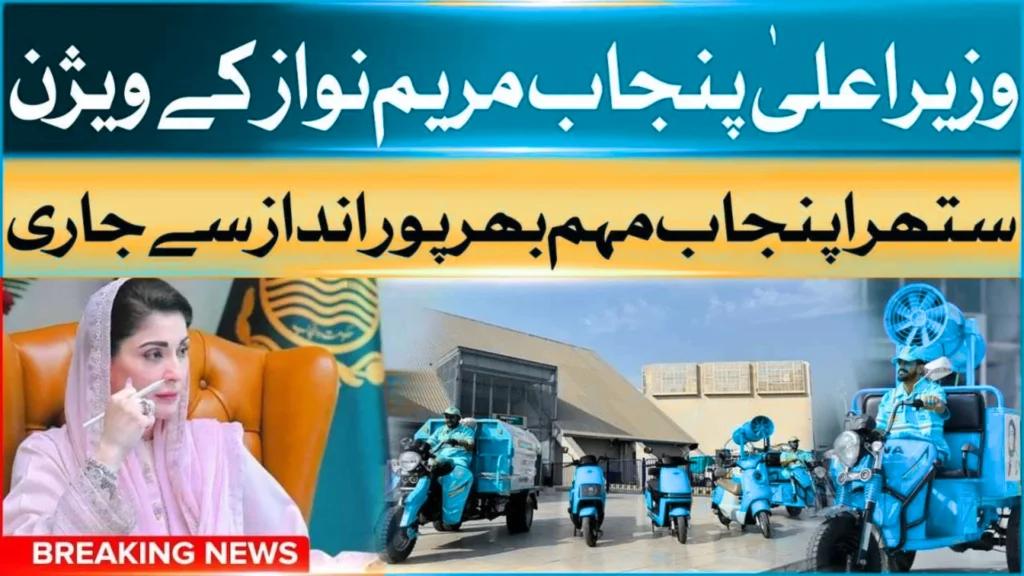
What is the Suthra Punjab Program?
The Suthra Punjab Programme is a large-scale sanitation and waste-management drive launched by the Maryam Nawaz Sharif-led government in the province of Punjab, Pakistan. According to the official portal, it aims for a “Zero Waste Punjab” target and covers both rural and urban areas.
Initially launched on 3 December 2024, the programme features modern vehicles, equipment, geo-tagged monitoring systems, a dedicated helpline (1139) and the “Suthra Punjab Shehri” mobile app for citizen participation.
Why the November 2025 Update Matters
By November 2025, the Suthra Punjab initiative is shifting from its start-up phase into a more consolidated operational mode. This update is important because:
- It provides progress figures and early impacts.
- It outlines new operational features (zones, billing, monitoring upgrades).
- It signals how citizens can engage and what changes to expect in the coming months.
Key Figures & Features (as of Nov 2025)
Here’s what the latest data tell us about the programme’s scale and progress:
| Metric | Detail |
|---|---|
| Coverage | All 149 tehsils of Punjab covered under the programme. |
| Estimated waste-handling capacity | Over 60,000 tonnes per day of solid waste in Punjab. |
| Employment created | More than 100,000 jobs in cleaning, collection, monitoring. |
| Monitoring & technology | Geo-tagged pickups, real-time dashboards, mobile app tracking. |
| Citizen feedback channels | Helpline 1139 + Suthra Punjab Shehri app. |
What’s New in the November 2025 Update
From recent public reports and programme documentation, these changes stand out:
- Zero-Waste Zones: Specific areas (urban clusters) are being designated with stricter rules on dumping, burning and waste separation.
- Billing & Incentives: Some households and commercial entities are now subject to monthly charges or bonuses depending on segregation compliance.
- Waste-to-Energy Pilot: Certain districts are being prepared for conversion of collected waste into energy, reducing landfill reliance.
- Expanded Rural Operations: While initial implementation focused on cities, rural tehsils are now being fully integrated; e.g., 21 tehsils of Rawalpindi division launched full operations.
How It Works For Citizens
If you live in Punjab and want to understand how the programme affects you, here’s a straightforward breakdown:
What you need to know
- Waste collection will increasingly be door-to-door on a scheduled route.
- Local cleaning teams will use vehicles with real-time tracking so the responsible department can monitor performance.
- If you spot missed pickups, overflowing bins or illegal dumping, you can:
- Call helpline 1139
- Use the “Suthra Punjab Shehri” app to log your complaint.
How to engage
- Sort your waste: Ideally keep recyclable, organic and non-recyclable separate (where local collection allows).
- Follow any area-specific rules: Once your tehsil becomes a “Zero-Waste Zone”, you might receive separate instructions.
- Give feedback: Your reports can help shape better local service and faster response.
Challenges & Considerations
While the programme has made headway, practical hurdles remain:
- In some remote villages, collection logistics are still difficult and local road access poor.
- Billing for waste collection is a newer concept in many neighbourhoods; public awareness needs boosting to avoid resentment.
- Ensuring contracting firms deliver consistent service across all 149 tehsils remains a management challenge.
- Cleaning after major festivals or flood events still spikes waste volumes quickly, the new waste-to-energy and segregation systems aim to help but are not yet fully mature.
What to Expect Next in Early 2026
Here’s what I expect based on current information and past patterns:
- The waste-to-energy pilots should expand to cover more districts, helping convert waste into usable power or fuel.
- More districts will complete the transition into “Zero-Waste Zones” with stricter enforcement.
- Data dashboards will become publicly accessible, allowing citizens to view how their tehsil is performing (collection rates, average response times).
- Community awareness programmes will intensify: schools, markets and neighbourhood groups will be engaged to ensure long-term behaviour change.
Conclusion
The Suthra Punjab Programme’s November 2025 update reflects a maturing system moving from launch phase into operational scale-up. If you live in Punjab, it’s worth paying attention to how this affects your locality, from how your trash is collected to how you can report issues and participate. A cleaner environment takes collaboration, and with these upgrades, the initiative stands a better chance of delivering lasting impact.
FAQs
1. What is the main goal of the Suthra Punjab Programme?
The aim is to achieve a “Zero Waste Punjab” by establishing consistent, province-wide waste-management and sanitation standards.
2. Who launched the programme?
It was launched by Chief Minister Maryam Nawaz Sharif in December 2024.
3. Does the programme cover both rural and urban areas?
Yes, both city and village tehsils of Punjab are included in the initiative.
4. What new features were introduced in November 2025?
New features include Zero-Waste Zones, waste-to-energy pilots, and billing or incentive structures for households or businesses.
5. How many jobs has the programme created?
More than 100,000 jobs in sanitation, waste collection, monitoring and related services have been reported.
6. How can I lodge a complaint if my area is missed?
You can call helpline 1139 or use the “Suthra Punjab Shehri” mobile app to register your complaint.
7. Do I need to pay anything as a citizen?
Some areas are now introducing monthly charges for waste-collection services, especially in Zero-Waste Zones. Check local notices.
8. Can citizens check performance data?
The government is moving toward public dashboards showing performance metrics like pickup rates and complaints resolved.
9. Will waste-to-energy matter for me?
Yes, in future waste that is collected may be converted into usable energy rather than just landfilled, which improves sustainability and may reduce long-term service costs.
10. Where can I find official information and updates?
Official information is available on the Punjab government portal.





